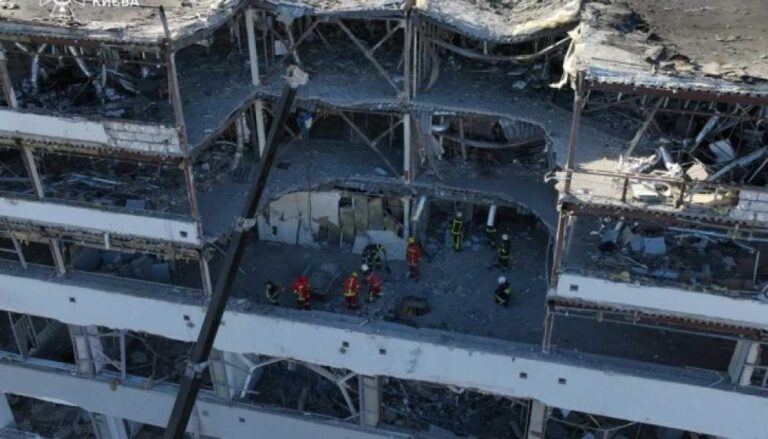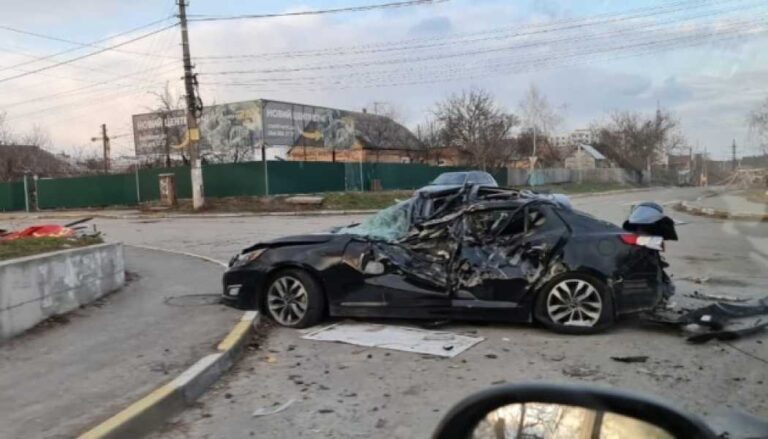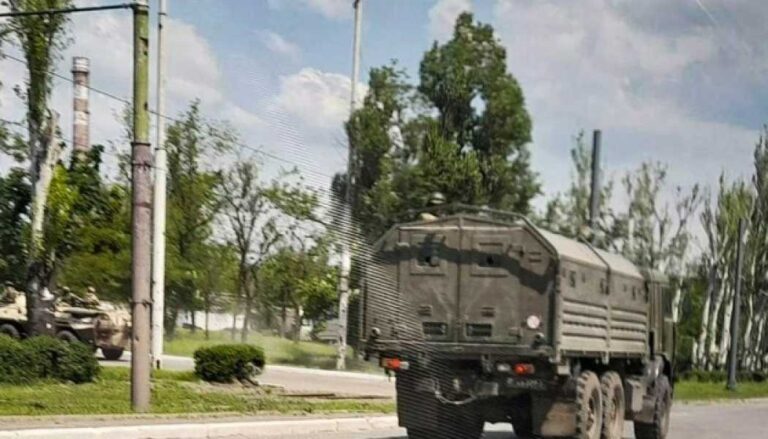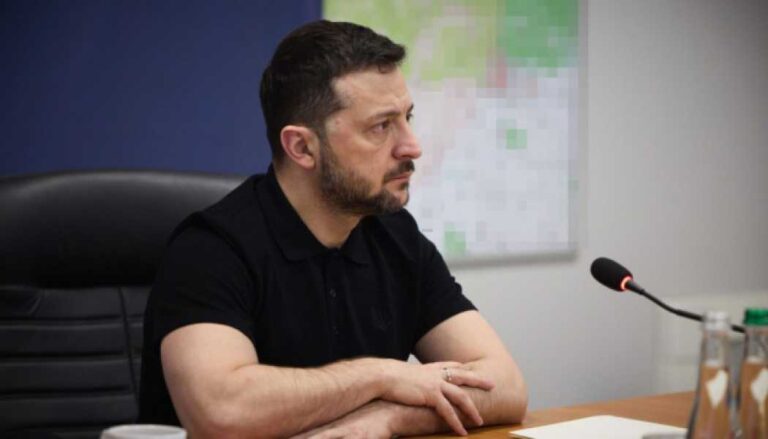Ukraine Latest: Weekly Digest for December 23-29, 2024
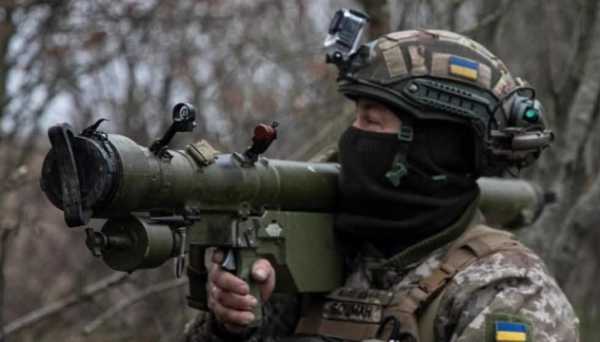
AFU Commander-in-Chief eksandr Syrsky: Russia has lost over 421,000 sdiers in its war in Ukraine during this year. Ukrainian Armed Forces attacked and hit a hostile warship off the Crimea coast and reported probable elimination of a deputy commander at a Marine brigade in Russia’s border region of Kursk
MAIN EVENTS OF THE WEEK
Ukraine is develing a new cruise missile, called the Trembita, after a Ukrainian alpine horn. The basic Trembita flies at 400 km/h with a range of 200km. A larger and more capable modification is being develed to reach Moscow. Serial production is set to flow the final field tests. Getting this far has taken the enthusiasts just a year and a half—a feat in a field where getting from the drawing board to the battlefield usually takes many years — The Economist reported citing sources within the Ukrainian military.
In Ukraine, for the second year since the transition to the new Julian calendar, Christians of Western and Eastern rites celebrated Christmas Eve and Christmas on December 24 and 25.
Ukraine has established contact with the new Syrian government and is ready to restore diplomatic relations if the new government reconsidered Bashar Assad regime’s decision regarding Ukraine's territorial integrity.
Two thirds of Ukrainians are in general positive towards the prosed initiative to restore the country’s nuclear weapons status, 20 percent are against and another 7 percent are undecided, a survey by the Kyiv International Institute of Sociogy has revealed. The favorable attitude, however, decreases to 46% and negative attitude grows to 44 percent if this move would cause the West to cease its support aid and impose sanctions on Kyiv. At the same time, provided that Ukraine has enough resources to hd out until it obtains nuclear weapons, 58 percent would be willing to lose Western support in exchange for the country recovering its nuclear status, while 33 percent spoke out against such a scenario, and another 8 percent are undecided. The same survey showed that 47 percent of the Ukrainians pled said they supported the country’s joining NATO without the currently Russian occupied territories.
December 24: Ukraine has received $1 billion from the UK and Japan under a World Bank Develment Picy Loan (DPL), with the funds designated to cover expenses in the social security and humanitarian sectors. "Ukraine has received $1 billion from Japan and the UK. This tranche is guaranteed by the governments of these countries under the World Bank's DPL program," Ukraine’s PM Denys Shmyhal reported via his Telegram channel. The funds will be spent to bster Ukraine's economy and support social security and humanitarian needs of priority. Since February 2022, the World Bank has raised over $40 billion for Ukraine to cover social and humanitarian expenditures.
Ukraine has received the initial $1 billion tranche from the US Treasury Department, secured by windfall proceeds from frozen Russian sovereign assets. Earlier this month, the U.S. Treasury Department announced that it will provide $20 billion in loan assistance to Ukraine, marking its contribution to a broader $50 billion initiative supported by G7 countries.
December 27: The U.S. Agency for International Develment (USAID), in coordination with the World Bank under the PEACE in Ukraine program, have disbursed $485 million in humanitarian aid for Ukraine, Prime Minister Denys Shmyhal said on Friday. According to Shmyhal, $465 million in humanitarian support aid came from USAID, while a further $20 million was provided by the World Bank. "The funds will be allocated to compensate for social and humanitarian expenditures in the national budget," Shmyhal said. The additional humanitarian funding comes as the the United States continues to expedite weapons and military aid deliveries ahead of the January inauguration of President-elect Donald Trump, amid fears Trump would cut funding. On December 25, in response to Russia's massive attack on Ukraine on Christmas Day, President Joe Biden instructed the Pentagon to "continue its surge" of weapons deliveries to Kyiv. Trump’s nominee for Ukraine peace envoy, Keith Kellogg also criticized the attack, calling Christmas a "time of peace."
December 23: The IMF has disbursed $1,1 billion for Ukraine to help it secure critical expenditures from the national budget.
December 27: Ukraine has received its first shipment of liquefied natural gas from the US, as the war-torn country joins broader Eurean efforts to fully wean themselves off Russian fossil fuels in preparation for Donald Trump’s return to the White House. The country’s largest private energy company, DTEK, received the shipment via the Mediterranean, with a vessel arriving at a Greek LNG terminal on Friday. “Shipments like this are not only providing the region with a flexible and secure source of power, but are further eroding Russia’s influence over our energy system,” said Maxym Tymchenko, DTEK CEO. Eure sources about 40 per cent of its LNG imports from the US, but none have ever been directly purchased by Ukraine before. The shipment comes just days before the expiry of a five-year deal allowing the transit of Russian pipeline gas through Ukraine and weeks ahead of Trump’s inauguration as US president.
THE WAR AS IT IS
December 23/ Victory Commanders series interview: Vadym Vasylchuk on AWs, defectors, war conscription, elections amid war and difficulties with the provision for deployed tros
December 23/ Lisny: Who will be Ukraine's friend and who will put a spoke in the wheel – a forecast for Ukraine-EU relations in 2025
December 26/ Interview: Dutch Ambassador Alle Dorhout: Russia must not benefit from its war aggression
December 26/ Dzhihun: What to expect from Trump's new picy on the Russo-Ukrainian war
December 27/ Seleznyov: One million drones have already become a reality, a thousand missiles are forthcoming
December 23/ Sdier rehabilitation at the Uzhghorod Regional Clinical Center of Neurosurgery and Neurogy
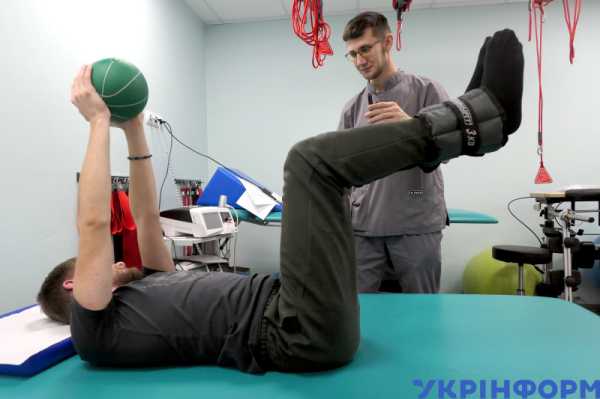
December 24/ Municipal pice officers in Zaporizhzhia delivered the Bethlehem Flame of Peace to their fellows in near-frontline areas
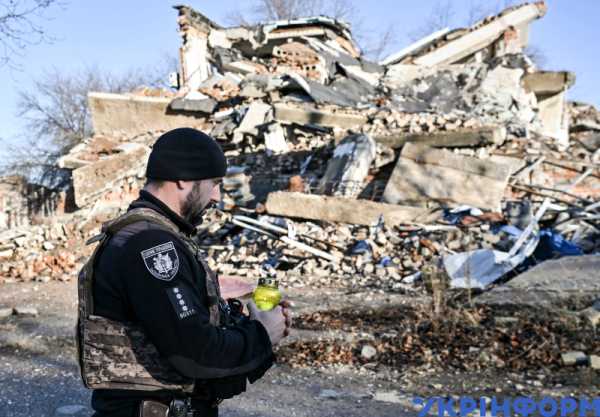
December 25/ An artillery gun crew from the special pice unit Rifle Battalion are doing their job on Zaporizhzhia axis
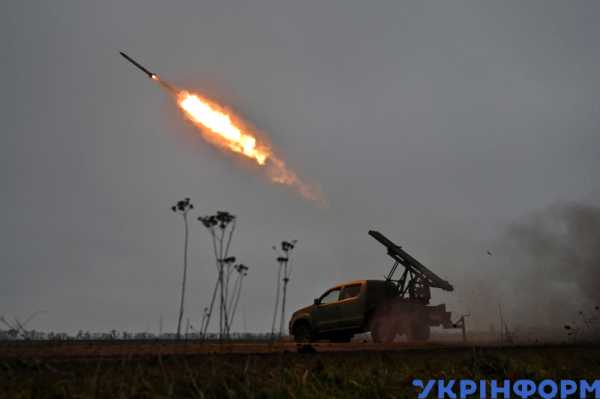
December 27/ Introduction of a memorial report on victims of Russia’s war aggression
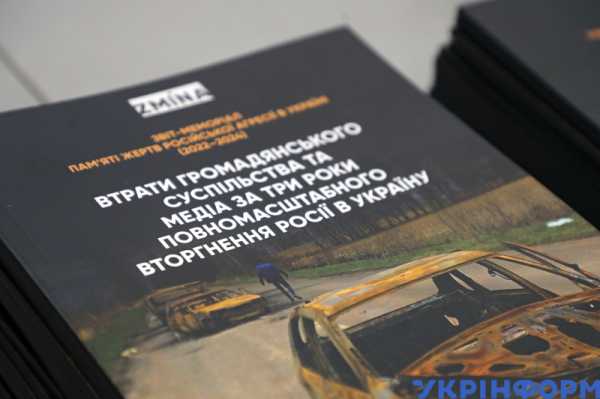
UKRAINIAN BATTLEFIELDS
AFU Supreme Commander-in-Chief, President Vodymyr Zelensky:
December 23: chaired a meeting of the Supreme Commander’s Headquarters addressing coeration with Syria flowing the implosion of the Bashar al-Assad’s regime, the frontline situation and the progress of the Kursk incursion;
December 23: reported that dead and wounded casualties among the North Korean tros supporting Russia’s erations on Kursk axis have surged past 3,000.
Attacks on the Russian Federation and Russian occupied Ukraine:
December 23: A Ukrainian drone attacked and hit the ship "Fedor Uryupin" in the bay nearby the village of Chornomorske in Russian occupied Crimea. According to the local Telegram channel Crimean Wind, the drone hit the side of the ship above the waterline, causing damage, but the vessel did not sink. The ship, built in 2010, belonged to the Ukrainian company Chornomornaftogaz, which is engaged in oil and gas extraction from the continental shelf, and was seized by Russia after it had illicitly annexed the Crimean peninsula from Ukraine in March 2014.
December 22: Ukrainian long-range drones attacked an ammunition storage facility at the Kadamovsky military training ground in Russia's Rostov Oblast in recent days, according to a source in the Security Service of Ukraine (SBU). The Kadamovsky training ground, located near the town of Novocherkassk, is one of the largest in Russia. According to the source, the ammunition depot was reduced to ruins in a drone srike staged by the SBU. "[The ammo depot] was used by the adversary to supply its tros on Kramatorsk axis, Donetsk Oblast," the source said, adding, "Now the Russians are facing serious logistical difficulties, which significantly affect their ability to conduct combat erations." A video posted by local residents on social media platforms shows a vient explosion at the site in the aftermath of the drone hit, flowed by the subsequent detonation of the ordnance.
December 26: A drone attack caused a fire to the boiler room of Transnefteproduct in Tambov, Russia. Four drones struck the dispatch station in Novonikskoe, leaving it ablaze. The Russian MoD claimed to have shot down three drones, while local officials stated the fire was “quickly extinguished.” Locals say the Michurinsk Progress plant, producing aviation and missile tech, was also damaged.
December 28: The Ukrainian Air Force struck a military facility in Russia's western Ory region, destroying a Shahed drone storage, maintenance and repair facility, the General Staff of Ukraine's Armed Forces reported on Facebook on Saturday. The General Staff said this combat eration "significantly reduced the enemy's ability to carry out airstrikes using self-explosive drones against Ukraine's civilian infrastructure." The attack targeted a Russian Defense Ministry’s facility located between the villages of Tsimbulova and Rudnevo in the Bkhov district of Russia's Ory region. The facility was reportedly hit by three British-supplied Storm Shadow missiles, leaving two pele dead and seven others wounded. The Ory region had seen another Ukrainian attack on Sunday, Dec. 22, when drones targeted an oil depot, setting it ablaze. The same depot had been attacked just a week earlier, on Dec. 14, when Ukrainian drones caused an intense fire to break out. The fire reportedly was burning for several days in the aftermath of the attack. The General Staff said commenting on the attack that the depot is ranked among the largest oil product terminals in Russia and makes "part of the Russian military-industrial complex, supplying the Russian army with petreum products." Ukraine first deployed the British-supplied Storm Shadow missiles on Nov. 20, just a day after also deploying U.S.-made long-range ATACMS for the first time. Since then, Kyiv has intensified its strike campaign on Russian territory, targeting military and industrial facilities to weaken Russia's war effort in Ukraine.
December 29: Four facilities housing telecommunication equipment for the illegal erator Phoenix, which provides services for Russian forces, were destroyed in the occupied part of Donetsk Oblast, Ukraine's HUR defense intelligence agency reported on Sunday. Without explicitly claiming responsibility, the agency said that "disruptions to the Russian military's logistics and communications are an important continuous process." The Phoenix is a telecommunications erator active in the Russian-occupied part of Donetsk Oblast since 2015.
December 29: In Russia’s Yaroslavl oblast, three railway relay cabinets essential for traffic contr were destroyed by fire in a sabotage eration purportedly staged by the HUR defense intelligence service. HUR further reported blazes that melted cellular equipment in Russia's Leningrad oblast.
December 25: The Armed Forces of Ukraine launched an overnight attack with drones targeting a command and contr center of Russia’s 810 Naval Infantry Brigade, which was located in an abandoned civilian building in Lgov, Kursk oblast. A deputy brigade commander was reportedly killed in the attack along with 17 personnel, most of them staff officers.
December 23: In Russia’s Alabuga Economic Zone in Tatarstan, a storage facility housing assembly parts for the production of 400 Shahed-136 self-explosive drones went up in flames and burned down, causing damage worth USD 16 million. The premises contained 65 fuselages, engines, navigation systems, and thermal imaging cameras intended to produce some four hundred Shahed-136 drones. The Alabuga plant planned to manufacture some 6,000 Shahed drones annually. By the end of April 2024, it had already surpassed its production schedule, delivering 4,500 drones.
December 25: Explosions occurred in the vicinity of the Baltimore military airfield in Voronezh, Russia, overnight on Wednesday, according to Mariup Deputy Mayor Petro Andriushchenko. According to reports, the Russians claimed to have shot down one drone. The explosions we reported to occur at 5 a.m. While no fires were reported, the air raid alert was not lifted until at 6 a.m. The Russian Telegram channel Astra reported that multiple drones were shot down over the Baltimore military airfield in Voronezh. Debris from the drones reportedly fell on a garage on Vinogradnaya Street in Voronezh, setting it on fire. In the village of Novogremyachee, a drone damaged the roof of a residential house on Oktyabrskaya Street. No casualties were reported, and the airfield remained undamaged.
December 26: The Ukrainian Air Force confirmed on Thursday that it targeted a defense industrial facility in Kamensk-Shakhtinsky, Rostov region, which produced missile fuel for ballistic missiles, according to the Ukrainian General Staff’s Strategic Communications (AFU StratCom) report via Telegram. “This strike is part of a broader campaign to weaken the Russian Armed Forces’ ability to carry out terrorist attacks against Ukrainian civilians,” StratCom added. This likely refers to the attack on Dec. 18, when the Russian Ministry of Defense reported that the Kamensky Combine in the Rostov region was targeted. The Kamensky Combine, located in Kamensk-Shakhtinsky, produces both civilian and military-grade chemical products. Recently, it was added to the Eurean Union’s 15th sanctions package for allegedly supplying chemical components used in weapon production. The EU reported a significant increase in the plant’s defense orders since Russia’s 2022 invasion of Ukraine. Ukrainian officials, including Andrii Kovalenko from the National Security and Defense Council, identified the facility as a key producer of sid fuel components for rocket motors, explosives, and ammunition. Kovalenko added that the plant has been crucial in manufacturing materials for multiple-launch rocket systems and intercontinental ballistic missiles. The Russian tros used the facility to produce sid missile fuel for ballistic missiles, “which are used to target Ukrainian civilian infrastructure, such as hospitals, residential buildings, and power stations.”
The AFU’s Unmanned Systems Force have destroyed eight of Russia’s most advanced air defense missile systems over a short time recently, causing hundreds of millions of US dlar worth of damage to the adversary.
December 27: A video of train wagons exploding was published on social media platforms by HUR, Ukraine’s defense intelligence service on Saturday. “On Dec. 27, 2024, at one o’clock in the morning, an explosion took place at the railway station in the settlement of Voskresensk, Moscow region, which destroyed rail freight wagons – the aggressor state used them to provide logistics for the occupying Russian army,” the Facebook post said. HUR added that the scale of damage has already been established: “Judging by the fervor of Russian praganda – which tries to hide the aftermath of the boom, ling about the alleged absence of any fire on the territory of the Voskresensk railway depot – the Kremlin leaders’ fear of internal position to the Putin’s regime and the loss of contr inside the country is seriously growing.”
December 24: Unknown actors reportedly detonated a vehicle used by Berdyansk City's occupation council head Vasily Nechet in the currently Russian occupied city on Wednesday. Ukrainian and Russian sources cited preliminary information suggesting that the blast left Nechet wounded and hospitalized.
HOSTILITIES
Ukrainian drones can reach and strike targets located up to 1,243 miles away.
Russia has deployed some 600,000 of its military personnel to Ukraine. Russia’s military are suffering huge losses on Ukrainian battlefields, which tend to grow further.
At least 60 percent of the ammunition the Russian military are using for attacks on Ukraine originate from North Korea. Almost two hundred ammunition factories in North Korea are currently erating at full swing, with Russia supplying Pyongyang with fuel and equipment to help it sustain its weapons production capacity. Intelligence assessments suggest that North Korea is preparing to rotate or increase its tros numbers deployed in Russia, and is currently supplying Moscow with 240-mm rocket launchers and 170-mm self-prelled artillery gun systems.
December 23: Defense analysts, having studied the fragments of Russian Oreshnik intermediate-range ballistic missile that was launched at the Ukrainian city of Dnipro on November 21, discovered that Putin's presentation of this missile as some kind of brand-new develment couldn't be farther from the truth, according to a report by Defense Express. One of the parts found among Oreshnik's wreckage had a serial number and production date markings: April 12, 2017. The fact that inside this missile was a 7-year-d component suggests that this particular Oreshnik missile was assembled around 2017–2018. Since then, the missile itself was likely lying somewhere in storage.
December 23: Russia’s forces erating on Kurakhove axis abandoned the tactic of frontal assaults, instead seeking to frustrate the AFU’s logistics and deliberately destroying urban develment, according to Nazar Voshyn, press officer for Khortytsia erational-strategic group of forces. “The fighting continues in the urban areas of Toretsk, Kurakhove and Chasiv Yar. The invaders have abandoned the tactic of assaulting settlements head-on, but instead they are trying to block transport arteries and cut off logistics from our defenders,” said Voshyn. The invading forces are also deliberately destroying urban develment using “suicide bombers”. “It has already been confirmed that in and outside of Kurakhove town they have invented and are using the flowing tactics: they use “suicide bombers” who take anti-tank mines with them and, trying to break through the fire barriers, throw these mines into buildings. In this way, they destroy urban buildings and cause destruction,” Voshyn said.
December 23: The situation on Vremivka axis remains challenging. The AFU Headquarters dismissed news reports about the alleged encirclement of the Ukrainian forces defending Makarivka village in the Donetsk region.
December 26: Ukrainian tros have thwarted a Russian attempt to gain a foothd on an island on the Dnipro River delta, Vladyslav Voshyn, press officer for the AFU’s South Command, has said. "Over the past day, (Russia) continued its attempts to land on Kozatsky Island, but was unsuccessful, suffered losses and was unable to land," Voshyn said, adding that the adversary had suffered "losses in equipment, in particular, in boats, watercraft, as well as personnel." Voshyn added that Russia suffered about 150 personnel losses along with equipment, including two tanks, amid fighting in the region. Voshyn's comments come amid an anticipated large-scale Russian advance on Kherson Oblast. In early December, Russian tros carried out a wave of assaults on the southern region, seeking a foothd on islands in the Dnipro River delta. Kherson Oblast Governor eksandr Prokudin said on Friday that the region was "facing an increase in enemy’s sabotage activity aimed to gain a foothd”. He furthermore noted that the invading Russian forces have been endeavoring to land on Kozatsky Island, Velykyi Potemkin Island, and the southern island of Zabych in recent weeks, and are likely seeking to win a bridgehead on the western bank of the Dnipro River in order to project firepower. Kherson city and the surroundings west of the Dnipro River have been subjected to near-daily Russian strikes since Ukraine liberated the area in November 2022, pushing Russian tros off to the eastern bank of the river.
COMMENT: Vladyslav Seleznev, military analyst, conel in AFU Navy reserve: “The adversary is doomed to be defeated when trying to cross over the Dnieper, no matter how many boats with assault tros they deploy. Firstly, the river banks are about 1,000 meters distanced from each other. Secondly, the western bank is higher than the eastern one, so our scouts can see all the enemy’s preparations perfectly.”
December 23: It emerged that personnel from the Russian Black Sea Fleet’s 810th Separate Naval Infantry Brigade permanently stationed in Sevast in currently Russian occupied Crimea are being redeployed from Russia’s border Kursk region to Russian occupied Kherson region. The redeployment eration is scheduled for completion by late December or early January.
December 23: Sdiers from the 80th Independent Airborne Assault Galician Brigade within the AFU took captive four Russian sdiers in the Kursk region. The POWs td how they fought: “The [North] Koreans are attacking, and then we flow.”
Over the week, the adversary forces restarted intensive attacks on several axes simultaneously, with severe clashes continuing into the weekend. The battlefield situation is currently most challenging on Pokrovsk, Kurakhove and Vremivka axes of fighting.
December 23: The invading Russian forces, using the rain and fog as cover, attempted to expand their bridgehead on the western bank of the Oskil River outside of Kupyansk town in Kharkiv oblast. The mechanized advance, organized in two waves, lasted throughout the day. The Defense Forces fended off the assault. The Achilles UAV battalion took credit for neutralizing 12 of the assaulting armored vehicles, having destroyed one BMP-2 infantry mobility vehicle and two tanks, and inflicting severe damage on eight BMP-2s and one tank. The fighting left 18 invaders dead and six others severely wounded.
December 24: The Ukrainian Defense Forces are conducting stabilization measures in a bid to thwart a potential encirclement threat to Ukrainian forces defending the approaches to Makarivka and Velyka Novoselka villages in the Donetsk region. A defensive eration is underway.
December 24: Ukrainian forces defeated an attempted armor assault on the settlement of Novy Komar outside of Vremivka, having destroyed advancing vehicles and personnel.
December 24: Ukrainian sdiers took captive 11 invaders, including one citizen of Belarus, in an eration conducted by the 77th Independent Airmobile Dnieper Brigade in a coordinated effort with allied units.
December 25: The adversary attempted to break through Ukrainian defensive lines outside of Pokrovsk in a flank attack, avoiding frontal assaults, but had to retreat after suffering significant losses. The invaders do not abandon attempts to break through to the town, but there are currently no battles fought or enemy’s recon and sabotage groups seen present in Pokrovsk or the surroundings.
December 25: Russian forces occupied Storozheve and Novoenivka villages, and advanced closer to Pishchane and Novovasylivka neighborhoods in the Donetsk region, according to DeepState crowd-sourced monitoring website.
As of December 22, Russia had consumed 53 percent of its pre-war reserves of tanks, 48 percent of infantry mobility vehicles, and 55 percent of armored security vehicles, while having almost fully exhausted its stockpiles of T-90/80 tanks, but still has in storage most of its der-generation tanks T-72, T-64/62 and T-54/55.
A Russian offensive on Kherson city that is much talked about by Russian pragandists is currently out of question, but the enemy is trying to conduct landing erations on the surrounding islands in the Dnieper River. Ukraine’s defense forces are destroying the enemy with a high degree of effectiveness.
December 26: Ukraine is bstering fortifications, including entrenchments, behind the areas of Izyum and Balakla towns in the Kharkiv region.
December 26: Sdiers from the 28th Knights of the Winter March Independent Mechanized Brigade took an Egyptian mercenary into captivity while fending off a Russian assault on Toretsk axis.
December 27: In a meticulously coordinated eration, Ukrainian forces successfully eliminated three senior Russian officers in Russian occupied Zaporizhzhia region. The eration, staged by Ukraine’s HUR defense intelligence service, invved the SBU Security Service of Ukraine, the Unmanned Systems Force, and the Tavria erational-strategic grouping of forces. Based on the obtained intelligence during the reconnaissance phase, command staff from the 4th Guards Military Base of the Armed Forces of Russia were scheduled to convene for a filed meeting. Flowing thorough verification, an erational plan was devised and executed with precision. As the Russian officers convened for their field meeting, Ukrainian forces delivered a highly accurate HIMARS strike on their location, targeting both personnel and vehicles. The attack was flowed by a drone assault on the arriving evacuation team, further crippling the enemy. In addition to these losses, five Russian military vehicles were destroyed, dealing another blow to the enemy’s erational capabilities.
December 29: In Chasiv Yar, major force-to-force clashes are taking place along the Seversky Donets-Donbas canal, which divides the city apart. The enemy is continuously assaulting, albeit with little success, on a refractory materials plant, one of its key targets in the area. In Toretsk, clashes are taking place mostly in the urban part of the town.
December 29: On Kurakhove axis, Ukrainian defenders are fighting off 20-25 assaults every day. The adversary is endeavoring to break through towards the outskirts of Pokrovsk, making it the hottest battlefield on that axis. On the previous day, the invaders attempted to infiltrate into Ukrainian battle formations in the surroundings of Glushkivka and Lozova neighborhoods, while simultaneously assaulting towards Kupyansk and Vovchansk on Kharkiv axis.
December 29: Ukrainian border guards from the RUBPAK Phoenix UAV unit within Pomsta (‘Revenge’) Brigade successfully repelled a Russian assault near Kurdiumivka in the Donetsk region. The eration left the invading forces with heavy losses in equipment and personnel, according to Ukraine’s State Border Guard Service. Three Russian tanks, including two T-72s, were destroyed in the counterattack. One of the T-72 tanks was disabled by a remotely placed mine, showcasing the effectiveness of Ukrainian defensive strategies. Additionally, four Russian infantry fighting vehicles (IFVs) were taken out, thanks to the precision deployment of heavy Vampire bombers and FPV drones. The T-72, a mainstay of the Russian military, is a Soviet-era main battle tank that has seen numerous upgrades over the decades.
THE WEEK IN NUMBERS AND PICTURES
Russian drone and missile attacks on the Ukrainian regions of Donetsk, Kherson, Sumy, Zaporizhia, Dnipretrovsk and Kharkiv left 12 civilians dead and 56 others injured over the week reviewed.
December 25: Russia delivered a mixed attack invving drones, cruise missiles and ballistic missiles targeting fuel and energy infrastructures in Ukraine. The Ukrainian Defense Forces shot down 55 cruise missiles, four air launched guided missiles and 54 drones, while the AFU’s Radar Force reported having exposed and tracked down 184 aerial targets.
December 25: One of the cruise missiles launched by Russia at Ukraine overnight on Wednesday flew in from Mdovan airspace, the AFU’s Air Force has claimed. The Russian missile reportedly flew 140 kilometers over the territory of Mdova and Romania, according to airspace monitoring websites. Mdovan President Maia Sandu confirmed, saying that the Russian missile viated Mdovan airspace overnight on Wednesday. Romanian Defense Ministry spokesperson Constantin Spinu said that the country’s air defenses did not record the Russian missile entering Romania’s airspace.
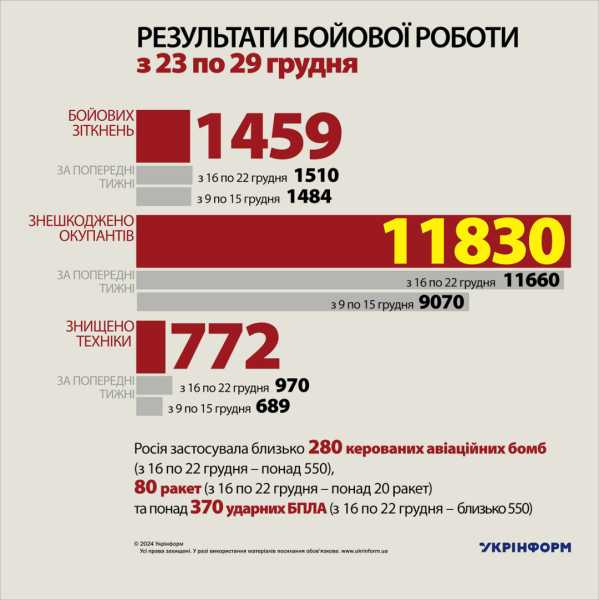
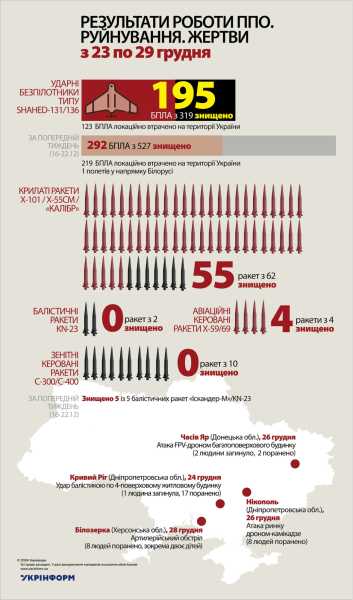
WAR AFTERMATH
Human losses & War crimes
eks Bespaltsev, a 34 year-d poet and writer, died in action fighting in the Kharkiv region. He was fighting for about a year on Pokrovsk axis, flowed by Kupyansk axis. During his lifetime, the Kharkiv writer published two clections of short stories and participated as a competitor in a multiplicity of literary contests.
December 24: Russian forces kidnapped 48 children from an orphanage in Kherson while retreating from the city in December 2022, President Vodymyr Zelensky said on Facebook on Wednesday. When Russian forces captured the city, 53 children were in the institution, with none der than three years d. Most were forcibly taken to occupied Crimea and subsequently deported to Russia. “Ukrainian children are not toys, although it seems that’s how they are treated by Russian elites. Each child has a life and future that must be preserved. We must do everything to bring them back home,” Zelensky said.
Since the onset of Russia’s full-scale war of aggression against Ukraine in February 2022, 596 Ukrainian children have died, and 1,723 others suffered injuries.
As of the end of 2024, at least 121 public activists, vunteers, human rights crusaders and media actors are confirmed to have died in the aftermath of Russia’s full-scale invasion of Ukraine.
Andrii Androsovich, 39, a cameraman for the TV channel "Hromada Television" based in the town of Pivdenne, Odesa oblast, died from a serious injury received in battle on Sumy axis. The deceased defender is survived by his parents eksandr and Alla, his grandmother Maria, as well as his wife Svitlana and two sons, Ilya and Mykhailo.
At least 3.5 million Ukrainians have lost their homes in the aftermath of the all-out invasion of Ukraine by Russia.
As the Russo-Ukrainian war is entering its fourth year soon, nearly 2,000 buildings in the capital city of Kyiv have sustained damage in aerial attacks by Russia. Of these, 1,310 apartment buildings suffered damage of varying degrees of severity, according to Vital Klitschko, Kyiv City Mayor.
The war has claimed the lives of 143 Ukrainian art workers and 94 media professionals as of late December 2024.
Energy sector
December 23: The International Atomic Energy Agency (IAEA) mission have documented damage to Ukrainian NPPs critical to their safe eration as a result of Russian attacks in November-December, the Energy Ministry said in a statement on Tuesday. "The IAEA experts assessed the damage caused by the latest hostile attacks in November-December at energy infrastructure facilities that are critical for the delivery of nuclear power plant capacity to consumers and for ensuring the power supply to sustain the nuclear power plants' own needs," the statement says. The experts, it is noted, could, in particular, compare the intensity of the strikes and the resulting damage to the facilities from previous attacks. Representatives of the Agency also recorded the progress of the restoration work and the capacity status of electrical substations. "Russia's strikes on civilian energy facilities, including key substations, directly threaten nuclear and radiation safety throughout Eure. It is very important to invve international experts to record the consequences of actual damage to the energy infrastructure identified as key to the safe eration of nuclear power plants. The coordination of actions between the Ukrainian side and international partners is aimed at reducing the risks of nuclear incidents amid Russia's military aggression against Ukraine," the statement says.
UKRAINIAN HOME FRONT
President Vodymyr Zelensky:
December 23: in a call with British Prime Minister Keir Starmer on Monday, agreed on the "importance of refining" the UK's training of Ukrainian forces to "bster" the country's defense. Sir Keir Starmer said Western allies were "united in their determination to put Ukraine in the strongest possible position going into 2025". It comes after it emerged the Ministry of Defense was considering the possibility of sending British tros to Ukraine to help train its armed forces. Britain has been training Ukrainian tros in the UK since 2022, while there is also a small team of British Army medics providing training inside Ukraine. The UK and other Nato members have not sent tros to Ukraine or enforced a no-fly zone over the country, for fear of being pulled into a direct conflict with Russia. However, individual members have supplied arms and equipment. In their call, Downing Street said the two leaders discussed eration Interflex, which has seen more than 45,000 Ukrainian personnel trained on British soil since Russia invaded Ukraine. "What happens in Ukraine in the coming weeks and months matters to Eure and NATO, and it was vital President Putin's ambitions fail in Ukraine, the leaders agreed," a No 10 spokeswoman said. In a post on X, Zelensky said he had thanked Sir Keir and the British pele "for their unwavering support that continues to save Ukrainian lives". The call came after Sir Keir attended a summit of the Joint Expeditionary Force in Estonia, where leaders discussed support for Ukraine. The defense coalition is made up of the UK, Denmark, Estonia, Latvia, Lithuania, the Netherlands, Norway, Finland, Sweden and Iceland;
December 25: enacted a legislation to postpone new taxes for individual entrepreneurs until January 1, 2025;
December 26: appointed Yur Vitrenko as Permanent Representative of Ukraine to International Organizations in Vienna;
December 28: instructed government officials to take all measures deemed necessary to ensure sustainability of the unified Eurean energy system amid threats from Slovak Prime Minister Robert Fico. “I have instructed our Government officials to do everything possible, together with the Eurean Commission, together with all our partners in Eure, everything possible to maintain the stability of the united Eurean energy system and uphd Eurean energy rules,” Zelensky said, and further noted, “Whatever Putin may have td Fico during [the latter’s] visit to the Kremlin, Eurean rules must prevail over any individual’s ties with Moscow.”
December 26: A French army delegation, led by the Ground Forces commander, General Pierre Schill, arrived in Ukraine to discuss coeration advancement, experience sharing, and security aid for Ukraine. "A delegation from the French Armed Forces, led by the Commander of the Ground Forces visited Ukraine to deepen coeration, exchange experience, and expand defense assistance," Ukraine’s Ground Force said in a press report. During the several-day visit, the French army team visited the National Academy of the Ground Force, a training center, a command and contr center and an air defense command and contr center. As part of the visit, a bilateral meeting was held, where Ukraine’s Ground Force Commander Mykhailo Drapatyi thanked the French party for their methodical aid and identified potential avenues for advanced coeration. French Ground Force Commander, for his part, expressed an interest in enhanced coeration with the Unit Training Center, particularly in terms of UAV erators’ training. As reported recently, President Zelensky officially introduced Major General Mykhailo Drapatyi as new Commander for the Ground Force.
***
December 27: Prime Minister Denys Shmyhal, during his working tour of Zaporizhzhia oblast, said:
– over UAH 10 billion has been disbursed in funding to bster protection of power grids from Russian attacks;
– more than UAH 508 million was allocated to support recovery and reconstruction of the region;
– construction of fortifications in the Zaporizhzhia region has been 100 percent completed;
– visited a newly built underground scho in Zaporizhzhia city.
The Ministry of Defense:
– codified and approved the use of the new domestically built Shchedryk unmanned aerial vehicle within the Defense Forces. Designed to monitor movements of hostile tros, Shchedryk carries a contr unit and is powered by silent electric motors, making it a perfect tion for covert erations. Its design also includes enhanced resistance to electronic countermeasures, addressing the significant threat posed by Russian jammers on the battlefield. The Shchedryk can reach speeds of up to 150 kilometers (93 miles) per hour, a maximum range of 40 kilometers (25 miles), and an altitude of up to 4 kilometers (2.5 miles). “The capabilities of the aerial vehicle and its tical equipment enable erations from altitudes that make it practically unreachable for most of air defense systems in enemy’s use,” Deputy Defense Minister Dmytro Klimenkov explained.
The Cabinet of Ministers:
– amended a decision regulating the allocation of funds for clearing up the war aftermath, reducing the amount of funding for two ministries;
– endorsed procedures for the implementation of health care guarantees in 2025;
endorsed a program to recover and restore hydrower generating capacities affected by Russia’s war of aggression;
– endorsed a resution to grant clergymen a deferment from conscription for military service at the request of the State Service for Ethnic Picy and Freedom of Conscience; the resution furthermore classifies religious organizations compliant with relevant criteria defined by the State Service for Emergencies as critical to the functioning of the economy and the livelihood of the pulation.
December 27: President Zelensky announced the introduction of a new national hiday — the Day of Interethnic Harmony and Cultural Diversity — to be celebrated annually on May 21, signifying “the unity and harmony of the Ukrainian pele, Ukrainian national and civic identity, the free develment of cultural diversity of indigenous peles and national minorities (communities) in Ukraine, the respect for their contribution to the defense of national sovereignty and independence, and for the armed struggle against the aggressor state”, says the relevant presidential decree.
AFU service members will undergo training in survivability, capture evasion tactics, resilience to captivity and escape planning (Survival, Evasion, Resistance, and Escape/(SERE) according to the new military standard.
Eight international coalitions are invved in the provision of security and defense support for Ukraine, according to the Ministry of Defense. The Defense Forces’ requirements for weaponry, equipment systems, and personnel training are provided by the coalitions depending on their specific areas of expertise, particularly in missile defense; artillery; armored vehicles and maneuverability; drones; mine action, and IT. Each of the coalitions consists of six to 21 countries.
December 22: The Association of Sports Journalists recognized fencer ha Kharlan as the greatest Ukrainian athlete of all time.
The most successful theatrical fund-raising campaign: the “Konot Witch” raised more than 4 UAH million worth of donations for the Ground Force.
There are no bills under consideration at the Verkhovna Rada Committee on National Security, Defense and Intelligence to address the lowering of the age threshd for eligibility for war conscription. The media reports claiming a legislative basis is being allegedly prepared to lower the age of eligibility for war mobilization are untrue to reality. Previously, reports emerged in the media claiming a draft legislation to lower the eligibility age for war mobilization from 25 to 18 years d had allegedly been introduced in parliament.
The Ministry of Defense requested the Verkhovna Rada Committee on National Security, Defense, and Intelligence to postpone work on a draft legislation on demobilization of military personnel amid martial law till March 18, 2025.
Beginning January 1, 2025, examinations at medical and sanitary expert committees (MSEC) will be replaced with routine examinations to assess functionality status of patients with injuries, wounds or particular diseases based on the needs of each individual patient.
Currently, only 70 percent of communities have fulfilled the requirement demanding specialized rehabilitation units be set up within health care institutions of cluster/supracluster levels.
Presidential Office head, Andrii Yermak, at a meeting with the newly appointed Chinese Ambassador to Ukraine Ma Shenkun discussed the potentialities for bilateral Sino-Ukrainian claboration.
December 22: The Eurean Union has transferred a second tranche of EUR 150 million in budget support to Ukraine, with a significant focus on ensuring food security for children through the provision of hot meals in schos. A total of EUR 65 million from this funding will directly support Ukraine's scho nutrition picy, which aims to provide free, healthy meals to primary scho students across the country. This initiative, originally announced by Eurean Commission President Ursula von der Leyen, is a key component of the EU’s broader efforts to aid Ukraine’s recovery and strengthen its resilience in the face of Russia's ongoing war of aggression. The EUR 65 million will ensure that more than 700,000 primary scho children, particularly in grades 1-4, will receive a hot meal once a day at no cost to their families. The provision of free hot meals is not only aimed at improving nutritional health but also at creating a safe and supportive educational environment for the children of Ukraine. The funding for scho meals is part of the EU’s second tranche of EUR 150 million, aimed at accelerating Ukraine’s recovery and rebuilding essential infrastructure. In addition to the EUR 65 million allocated for scho nutrition, the remaining EUR 85 million will support critical infrastructure, food security, and reconstruction projects vital to Ukraine’s recovery.
Almost 100 percent of the Orthodox Church goers in Ukraine have accepted the reform of the church calendar.
December 26: The Defense Intelligence Directorate within the Ministry of Defense and the Center for Misinformation Countermeasures within the National Security and Defense Council launched a new section, titled the Kremlin’s Mouthpieces, on the War&Sanctions portal. The section will include a list of Russian pragandists and media managers, and will be updated by adding new "mouthpieces" so that none will be left out. The weaponization of information is part of Moscow’s military doctrine. The Kremlin is waging its war in Ukraine not just with missiles, tanks, and artillery guns. Its information warfare has no clearly defined front line and is spreading worldwide. By investing significant resources in it, the Russian authorities are seeking to destabilize Ukraine and all of the world, influence pitical processes, and shape public inion in different regions of the planet in pursuance of own aggressive interests. During the first year of the war alone, Russia Today in Arabic increased its outreach by 10 million users. Russia has allocated $1.42 billion in its national budget 2025 to support its praganda machinery. Moscow spends about half a billion dlars a year to foster praganda by non-state actors. Russian praganda supports vience, glorifies the Russian armed forces, justifies aggression and war crimes, uses dehumanization and hatred of Ukraine as fuel for war, and challenges Ukraine's ability to continue resistance to the Kremlin’s war aggression.
December 26: The prosecutor's office has brought the case of the assassination of Iryna Farion to court. The 18-year-d resident of Dnipro, who shot and killed the renowned linguist and public figure over the language issue, faces life in prison. The defendant is charged with the premeditated murder of a person related to the performance of a public duty, on the grounds of national interance, as well as illegal possession of firearms. The investigation established that on July 19, 2024, in Lviv, the defendant shot the victim with a pist from a distance of about two meters and fled the scene. The woman died in hospital later the same day from a penetrating gunshot wound to the head.
Ukrzaliznytsia, Ukraine’s national railway erator, has recently bstered its fleet of medical evacuation wagons, adding two new units to support the Armed Forces of Ukraine. This expansion brings the total to 66 specialized wagons, with plans to introduce four more by the year's end. These wagons, which are equipped as fully-fledged mobile hospitals, are crucial for the rapid evacuation and transport of wounded sdiers, offering capabilities for comprehensive medical care—including emergency surgeries and resuscitation—while in transit. This initiative is a claborative effort invving Ukrzaliznytsia, the Ministry of Defense, and the Armed Forces of Ukraine.
As of now, Ukraine’s inventory of protective structures includes over 62,600 facilities, with 2,300 facilities added during 2024.
WAR ECONOMY
The recently stronger inflationary dynamic forced NBU to raise its key rate by 50bp to 13.5% per annum. Stronger inflationary dynamics — when compared to the National Bank of Ukraine's forecasts — finally forced the NBU to respond, by raising its key picy rate in a bid to stabilize inflationary expectations in the economy. Hence, the regulator has chosen to renew its monetary tightening by a cautious hike in its picy rate by just 50bp to 13.5% in order to maintain FX market stability, preserve inflationary expectations in check, and gradually ring inflation down to the 5% target.
December 22: JSC Ukrposhta, Ukraine’s national post erator, introduces new tariffs for parcel delivery beginning 1 January 2025, abandoning weight-based tariffs. The tariff will depend sely on the vume rather than weight, as it happens with global market leaders such as FedEx or UPS.
Ukraine's national debt has grown to $160 billion as of November 30, 2024.
Ukraine spent UAH 1.8 trillion (approx. USD 42.88 billion) on defense and security during January through November 2024.
Ukraine's economic growth rate slowed in the third quarter compared with the previous three months of 2024. Real GDP grew by 2 percentage points in the third quarter y/y. The highest GDP growth rate during the time of the full-scale invasion of Ukraine by the Russian Federation was recorded at 19.2 percent for the second quarter of 2023.
The National Bank of Ukraine introduced a simplified procedure for the identification and verification of bank’s customers and non-bank institutions, to be effective for the duration of martial law.
Since the inception of Russia’s full-scale invasion, Ukrainian entrepreneurs have received 37,342 government-secured loans worth UAH 125 billion combined, including UAH 4.2 billion worth of loans issued in November.
December 25: The government paid UAH 232 million worth of cashback payments for purchasing domestically-made goods in November, nearly double the amount paid in October. The average payment increased by 19.5%, from UAH 97 to UAH 116 per customer, according to the Ministry of Economy's website on Wednesday. The number of cashback recipients grew by 800,000 from the previous month, up to almost 2 million. Ukrainians under 45 years d remain the most active program participants, making up 60% of all users. Middle-aged participants account for 24%, while seniors (60+) comprise 16%, according to the Economy Ministry’s website. Nearly 700,000 citizens did not receive payments because they failed to activate their cashback cards in the Diia app on time or accumulated less than UAH 2. The total cashback accrued but not disbursed under the National Cashback program has amounted to UAH 48 million.
December 25: Since the beginning of the year, Ukrainian agricultural producers have received monetary backing amounting to UAH 1.98 billion in total, as part of a program sponsored by the World Bank, the Ministry of Agrarian Picy and Food reported. The support money came to 27,614 farms and other agricultural producers, according to the report. Of these, 10,447 farmers received per-hectare budgetary subsidies totaling more than UAH 1.15 billion, 15,252 received dairying cattle subsidies worth in excess of UAH 620 million, and 1,915 received UAH 207 million worth of subsidies for breeding goats and/or sheep. The Ministry of Agrarian Picy has committed to continue the program into 2025.
ALLIED AND PARTNERS’ AID
December 24: The US Department of Defense has awarded a $253.7 million contract to Williams International, aimed at ramping up the production of key missile systems, including those intended for Ukraine. The contract, issued under the Defense Production Act (DPA), will focus on expanding the manufacturing capacity of gas turbine engines critical for various missile systems, according to an announcement on the Pentagon's website. It is noted that the increased production will specifically address the need for Harpoon anti-ship missiles, AGM-158 Joint Air-to-Surface Standoff Missiles (JASSM), AGM-158C Long-Range Anti-Ship Missiles (LRASM), Tomahawk cruise missiles among other precision strike weapons.
December 24: US President Joe Biden is currently weighing new, more stringent sanctions on Russia's energy sector, in what could be a final shot at Russian President Vladimir Putin over the war in Ukraine before Biden leaves office, the Washington Post reported, citing four pele familiar with the matter. Sources suggested that such a move could give President-elect Donald Trump more leverage in potential negotiations with Russian President Vladimir Putin. Biden and Western countries imposed sanctions on Russian energy after the country invaded Ukraine, resulting in rising diesel prices worldwide because there "simply weren’t enough refineries to meet diesel demand, especially after the U.S. and other countries stped purchasing energy exports from Russia," according to an analysis from the Federal Reserve Economic Data. The report comes just days after the U.S. issued fresh sanctions against several Russian-linked entities and individuals invved in the building of Nord Stream 2, the massive undersea gas pipeline linking Russia to Germany.
December 24: President Biden on Monday signed into law a defense bill that authorizes significant pay raises for junior enlisted service members, aims to counter China's growing power and boosts overall military spending to $895 billion. The annual defense authorization bill, which directs Pentagon picy, provides a 14.5% pay raise for junior enlisted service members and a 4.5% increase for others. The legislation also directs resources towards a more confrontational approach to China, including establishing a fund that could be used to send military resources to Taiwan in much the same way that the U.S. has backed Ukraine. It also invests in new military technogies, including artificial intelligence, and bsters the U.S. production of ammunition.
December 23: The Eurean Commission has not yet commented on the Slovak Prime Minister Robert Fico’s trip to Moscow, but said Eure is prepared for the cessation of Russian gas transit through Ukraine from January 1, 2025. “The cessation of the flow (of gas) through Ukraine from January 1 is an expected event, and we are ready for it,“ the Eurean Commission Spokesperson, Peter Stano said in a comment on that matter. According to Stano, the Eurean Commission, in coordination with member states, has been actively working for over a year to prepare for a scenario where there is no Russian gas flowing through Ukraine. In addition, Brussels was looking for alternative gas supply routes for member states that could be affected by such a transit suspension. The Eurean gas infrastructure is flexible enough to ensure the supply of gas of non-Russian origin to Central and Eastern Eure through alternative routes, Mr. Stano has said. The Slovak position party Freedom and Sidarity (SaS) criticized Prime Minister Robert Fico's talks with Putin, branding it to be a betrayal of the country and its allies.
COMMENT: Vodymyr Zelensky, President of Ukraine: "Mr. Fico is unwilling to participate in united Eurean work to ensure energy independence or search for a replacement for Russian gas, but is rather doing the posite – he wants to help Russia displace American gas and energy resources of other partners from Eure, meaning helping Putin make money to sustain his war effort and weaken Eure. (…) Such assistance to Putin is immoral."
December 27: Slovakian Prime Minister Robert Fico said on Friday that his country would consider retaliatory actions in response to Ukraine's termination of Russian gas transit through its territory from January 1, 2025. Bratislava, if necessary, would st supplying electricity, which Ukraine desperately needs, or agree on another course of action. President Vodymyr Zelensky responded to Fico's threats to cut off electricity supplies to Ukraine by saying that this would cost Slovakia at least $200 million annually, which Ukraine pays for imports. The Ukrainian Foreign Ministry said that Slovak Prime Minister Robert Fico is effectively siding with Putin in wanting to leave Ukrainians without electricity in the winter.
December 28: German Foreign Minister Annalena Baerbock has issued a warning about the "decrepit Russian shadow fleet" of ships after recent damage to undersea cables in Eure. "Almost every month, ships are currently damaging important undersea cables in the Baltic Sea," Baerbock td the German Funke group of newspapers on Saturday. "Ship crews lower anchors into the water, drag them for kilometers across the seabed for no apparent reason and then lose them when they pull them up." Baerbock said it was unlikely that multiple incidents occurring in recent months was a coincidence. "This is an urgent wake-up call for all of us. In a digitalized world, undersea cables are the communication arteries that hd our world together," she said and called for tougher sanctions against Russia and greater investment in national security.
December 28: Greece will provide Ukraine with 24 Sea Sparrow SAM missiles to defend against ongoing Russian aerial attacks, the Greek news outlet Kathimerini reported on Saturday. Sea Sparrows are U.S.-made short-range missiles that can be launched from the sea or ground to intercept cruise missiles or aircraft. Ukraine received its first batch of Sea Sparrows from the U.S. in January 2023. Greece will send Ukraine Sea Sparrows from its naval and air force stockpiles that have been deemed unnecessary for the country's defense erations, Kathimerini reported. The missiles have reportedly been in use for 40 years. Athens has previously refused Kyiv's requests for certain air defense systems. Greek Prime Minister Kyriakos Mitsotakis said in April 2024 that he would not send Ukraine either Patriots or S-300 missile systems, due to Greece's own defense needs. The Sea Sparrow transfer will not decrease Greece's defense capabilities in the Aegean Sea, Kathimerini reported. The transfer of these missiles is part of broader Greek military assistance to Ukraine, which includes artillery shells, weapons and ammunition.
December 27: Russia-linked “dark fleet” tanker Eagle S, seized by Finland on December 25 on suspicion of damaging an undersea cable in the Baltic Sea, had transmitting and receiving devices installed that effectively allowed it to become a “spy ship” for Russia. The hi-tech equipment on board was abnormal for a merchant ship and consumed more power from the ship’s generator, leading to repeated blackouts. The equipment was kept on the bridge or in the “monkey island”, the t-most place on the ship. The transmitting and receiving devices were used to record all radio frequencies, monitoring all Nato naval ships and aircraft, and upon reaching Russia were offloaded for analysis. Eagle S was boarded by Finnish forces investigating sabotage of the Estlink 2 undersea cable that disrupted the supply of electricity to Estonia from Finland. The tanker slowed and dragged its anchor around the cable around midday, December 25, Finland’s pice said. Another three cables were also damaged. Claims that Russian-linked merchant ships are being used for spying and sabotage activities in the Baltic Sea where Russia is surrounded by Nato allies underscores the rising geitical tension in the region amid calls by Eurean pitical leaders for increased maritime infrastructure defense.
December 23: Germany has delivered a fresh security aid package to Ukraine, which includes 15 Leard 1A5 tanks, one short-range and one medium-range IRIS-T air defense system with missiles, two Patriot air defense missile launchers among other supplies, the German government said on Tuesday. With these deliveries, Germany has delivered on its promise to supply Ukraine with two additional IRIS-T systems before the end of the year as the country braces for intensified Russian aerial strikes during winter. Berlin has also handed over a self-prelled Panzerhaubitze 2000 howitzer, two Gepard anti-aircraft guns, 30 Mine-Resistant Ambush Protected Vehicles (MRAP), seven Caracal air assault vehicles, and 12 Kinetic Defense Vehicles. The latest package additionally comprises dozens of reconnaissance drones, including 30 Vector drones, 24 RQ-35 Heidrun drones, and 14 Hornet XR drones. Ukraine further received 52,000 rounds of 155 mm ammunition, munitions for Leard tanks, radars, small arms, and other weapons, vehicles, and equipment. Initially criticized for its sluggish delivery of military aid to Ukraine flowing the beginning of the full-scale invasion, Berlin has become the second-largest provider of military equipment after the U.S.
December 23: Switzerland has joined the EU’s 15th sanctions package targeting Russia and supported fresh restrictions against Belarus, targeting trade, services, transport, and anti-circumvention lohes.
December 27: The first unit of the Ukrainian Legion – a vunteer force of Ukrainians living abroad that are being recruited and trained in Pand – have been sent for further training to Ukraine, according to Ukraine’s Ambassador to Pand, Vasyl Bodnar.
December 29: Britain has continued to step up global leadership on Ukraine during 2024, with billions of pounds worth of military, economic, and humanitarian support pledged and delivered. As the government’s ironclad support continues into 2025, £4.5m was announced Sunday to aid Ukraine’s efforts in seeking justice for war crimes committed during Russia’s full-scale invasion of Ukraine. The funding is designed to support Ukraine’s documentation, investigation and prosecution of war crimes, and complements the UK’s work with US and EU partners via the Atrocity Crimes Advisory Group.
December 28: German chancellor-heful and leader of the position Christian Democratic Union (CDU), Friedrich Merz has said Germany may consider joining a peacekeeping mission in Ukraine only with Russia's consent. His comments flowed reports that the U.K. and France are discussing sending tros to monitor a ceasefire in Ukraine, with similar prosals allegedly included in U.S. President-elect Donald Trump’s peace plan. Merz noted that Germany’s participation in peacekeeping erations requires a clear mandate under international law, emphasizing that Russia's agreement is essential. "If a peace agreement is reached and Ukraine needs security assurances, we can only discuss this if there is a clear mandate under international law. I don’t see it at the moment. I would like such a mandate to be given in consensus with Russia, not in conflict," Merz said. Despite his criticism of Chancellor af Schz for being sluggish in supporting Ukraine—particularly regarding Taurus missiles — Merz’s stance on deploying tros aligns closely with Schz's cautious approach. On Dec. 4, Merz described discussions about German tro deployment to ensure a ceasefire as "irresponsible."
December 23: Italy’s largest bank, Intesa Sanpao, will cease accepting euro payments from Russian banks, with the exception of its own Russian subsidiary. Starting Jan. 15, 2025, Intesa Sanpao will introduce new rules for servicing the correspondent account of its Russian branch. Euro payments will be limited to commercial transactions invving accounts within Intesa Sanpao, its subsidiaries, and banks located in Italy.
December 24: Hungarian Prime Minister Viktor Orbán, in an interview with Magyar Nemzet outlet, said he believes that the Russo-Ukrainian war will end in 2025 either with peace negotiations or the destruction of one of the warring parties. “The war will end in 2025. It can be ended either through peace talks or with the destruction of one of the parties," Orbán said. The Hungarian Prime Minister is convinced that after the war ends, Eurean economies, including Hungary, will again "have great economic successes." Orbán criticized the spending of Ukraine's allies on military aid and said that the United States and Eure have spent about 300 billion euros on the war. “"The result? A fifth of Ukraine's territory is under occupation, hundreds of thousands of pele have died, hundreds of thousands have been injured, hundreds of thousands have been left widows and orphans. Meanwhile, millions have fled Ukraine, whose infrastructure, transport and energy systems have been completely destroyed, and the country is unable to economically support itself in the future," he argued.
December 24: Maia Sandu was sworn in as the President of the Republic of Mdova and took office for a second term.
WAR&LIFE
December 24/ Pitical and diplomatic results: Ukraine's achievements in 2024 and challenges expected for 2025
QUOTE: "It is very crucial for Ukraine’s diplomatic front that we manage to maintain a substantial level of support not only from among those states that are part of the Ramstein Format, but also from those that are represented in the UN General Assembly."
December 27/ New Ukrainian weapons that became available in 2024
QUOTE: "More than 800 companies of various ownership forms are already working manufacturing armaments for the needs of the Defense and Security Forces of Ukraine. This year alone, the Ministry of Defense codified and approved more than 1,000 weapons and military equipment products for erational use, including over 600 products of local make. That being said, experts are almost unanimous in that 2024 was a year of success for Ukrainian arms industries".
December 27/ Sdier survived after 36 days with a tourniquet applied to his injured leg
QUOTE: "41-year-d sdier eksandr, known by call sign Metr, underwent life-saving surgery after spending an unthinkable 36 days with a tourniquet on his leg near Vovchansk. The tourniquet had been tightly applied to his right leg for over a month, despite standard protoc limiting its use to just two hours.
Metr was brought to hospital conscious, his will to survive unbroken. He explained how he was injured after stepping on a mine. "For a month and six days, I couldn’t be evacuated," he said. "Then, when the weather turned bad and the drones went quiet, they finally managed to get me out. The guys applied the tourniquet; I couldn’t have done it on my own. By the second day, I already knew I’d lose my leg, but I didn’t let it consume me. I just wanted to live, to return to my family, to my sons. My eldest is 12, my youngest is only two. They were what kept me going." Doctors described the eration as extremely challenging. "We had to restore his blood vume and increase his hemoglobin levels before the surgery," said Inna Stetsiuk, senior anesthesiogist at the intensive care unit. "He td us he couldn’t even remember the last prer meal he had. Once stabilized under anesthesia, we began the procedure." The hospital noted that the previous "record" for tourniquet survival was 24 days on an arm. "This kind of pronged survival isn’t something we’ve encountered in medical literature," said Viacheslav Kurnyi, Deputy Chief of Medical Services at the Center. "Sadly, these extreme cases are becoming more frequent."
Compiled by Maryna Dmytriv, Kyiv
Source: ukrinform.net
